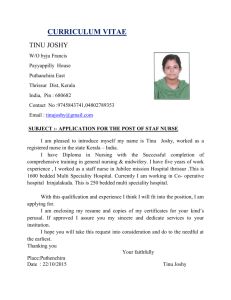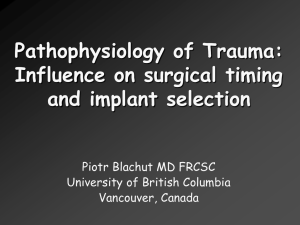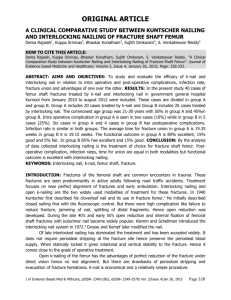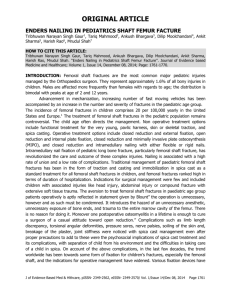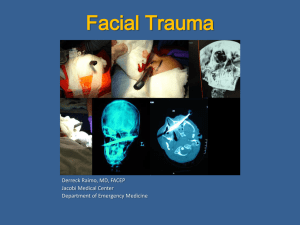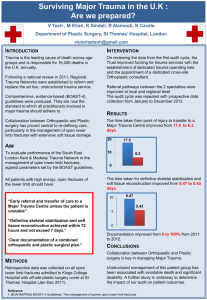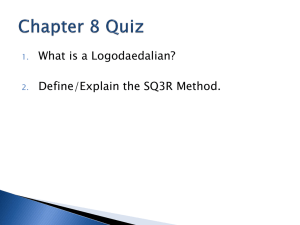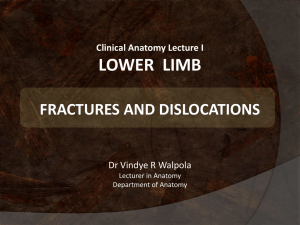G.H.
advertisement
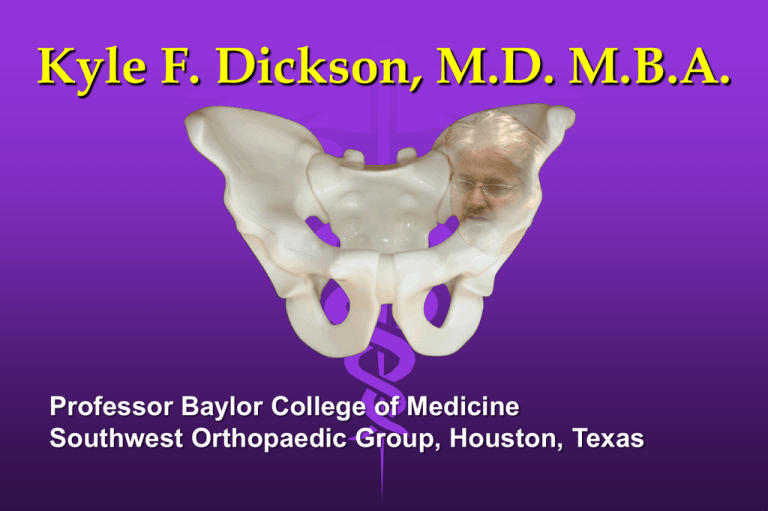
Kyle F. Dickson, M.D. M.B.A. Professor Baylor College of Medicine Southwest Orthopaedic Group, Houston, Texas Timing of Fracture Fixation in the Polytrauma Patient Kyle Dickson MD, MBA Professor Baylor College of Medicine Southwest Orthopaedic Group, Houston, Texas >5000 trauma admits with >1800 patients with ISS>15 (#1 ACS) Lecture Goals • • • Keep someone alive that would be dead without you Prioritize treatment to prevent killing someone Treat extremity injuries to return the patient to a functional life Topic Outline What do we know? The benefits of resuscitation The vast majority of patients benefit from early definitive long bone stabilization IM nailing of long bones has systemic effects Topic Outline Occasional patients are hurt by long bone nailing There is a systemic inflammatory response to major trauma Topic Outline What is unknown? How to predict bad consequences of long bone nailing The optimal timing of fracture repair for all patients Topic Outline The benefits of temporary external fixation The effect of a head injury JA • • • • • • 21 yo in MVA Bilateral femur fractures, open tibia L unstable pelvis, R T-type with pw R rib fractures with a hemothorax Splenic and liver laceration SBP 88, HR 136, intubated JA • • BD = 6 meq/l Temp = 33° Primary survey A. Airway maintenance with cervical spine protection B. Breathing and ventilation C.Circulation with hemorrhage control D.Disability: Neurologic status E. Exposure/environment control: undress patient but prevent hypothemia Morshed JBJS 2009 • Relative risk of mortality treatment weighted analysis • Delay > 12 hours for femoral shaft stabilization ↓ mortality 50% (especially serious abdominal injury) Problems • Fixing femur fractures may have nothing to do with mortality – but delay in fixation may be sicker patients – selection bias • Significant ↓ in mortality12-24h, 48120h and > 120 h - ? Not 24-48 h Our Study • Previous mortality of bilateral femur fractures 50% recently 25.9% (11.7% for unilateral femur fracture) • 6.7% (102/1519) mortality unilateral • 20.0% (15/75) mortality bilateral Our Study cont. • Multivariate logistic regression not significant for femur fractures • Highly significant for age group, pedestrian accident, and ISS group • ?fixed when stabilized and temporary ex fix Coagulopathy Hypothermia • Ca2 (blood citrate) • Acidotic Lethal Triad – hemorrhage, coagulopathy, inflamatory/metabolic • Coagulopathy & Trauma By the time of arrival at the ED, 28% (2,994 of 10,790) of trauma patients had a detectable coagulopathy that was associated with poor outcome (MacLeod et al., 2003) INR vs Mortality st 1 24 hrs in STICU E a rly IC U IN R v s P ro b a b ility o f D e a th p ro b ab ility 1 p = 0 .0 2 0 .8 0 .6 0 .4 0 .2 0 1 .1 1 .3 1 .5 1 .7 1 .9 2 .1 2 .3 2 .5 2 .7 IN R P = 0.02, ROC = 0.71 Hemostatic Resuscitation Blood/FFP/Cryo/Plts 1:1 ratio The benefits of resuscitation Uncompensated shock gross signs of circulatory deficiency (BP, HR, UO) Compensated shock ongoing suboptimal tissue perfusion The heart and brain are protected while the perfusion of other organs is inadequate Resuscitation - tissue acidosis eliminated and aerobic metabolism restored Emergent Extremity Issues Neuro vascular exam Splint extremities Compartment syndrome and dysvascular limbs Major dislocations Basic wound management Retrospective data from the 1980’s Early fracture fixation is good! Bone and Johnson JBJS 1989 Parkland hospital – 178 patients with femur fractures randomized to before 24 hours or after 48 hours Patients with ISS > 18 less pulmonary complications (ARDS, FE, pneumonia) Severely injured patients benefit the most!! Why does early fracture stabilization help the lungs?? Reduce continued marrow emboli Reduce pain and narcotic requirements Eliminates traction and supine positioning Less atelectasis and decreased pulmonary venous shunting Primary IM femur fixation in MTP with associated lung contusion – a cause of ARDS Pape et al JT 1993 106 pts with femur fracture and ISS > 18 In patients with chest trauma nailing within 24 hours led to greater ARDS (33% vs 7.7%) and mortality (21% vs 4%) The vast majority of patients benefit from early definitive long bone stabilization Retrospective studies Prospective Bone and Johnson 1989 Early femoral fixation leads to: Less complications Less ICU Less cost Better outcome for the limb There is no debate!! IM nailing of long bones has systemic effects Robinson et al JBJS b 2001 Trans esophageal echo and invasive monitoring during IM nailing Increase in PA pressure Decrease in arterial oxygen partial pressure Systemic change in markers of coagulation Systemic Effects of Nailing Brundage et al JT 2002 1362 patients over 12 years Femur fixation < 24 hours - improved outcome even with severe chest and head injuries “Resuscitation and hemodynamic normalization are essential parts of our protocol” Only 65% of patients were physiologically ready within 24H Highest incidence of ARDS in group fixed between 2 and 5 days - a time of heightened inflammatory response? There is a systemic inflammatory response to major trauma Injury activates cell defense mechanisms, producing mediators of coagulation and inflammation Protect against infection Remove damaged tissue Initiate repair Good!! However severe inflammation my lead to organ injury Bad!! The pro inflammatory response is increased by primary IM nailing Pape et al JT 2003 Prospective study - 35 patients The systemic inflammatory response measured by IL-6 was increased (55pg/ml-254pg/ml) by immediate IM nailing but not by ex fx and secondary nailing No difference in clinical outcomes 1st hit (trauma) FES SIRS 2nd hit (Surgery, infection, more FES) ARDS MODS MOF MSOF Occasional patients are hurt by long bone nailing Robinson et al JBJS b 2001 8/84 patients develop post op pulmonary compromise (7 were prophylactic for metastatic disease) Can we detect a patient at risk?? Injury factors - High ISS, pulmonary injury, severe abdominal injury, bilateral femur or other multiple long bone injuries Physiologic factors – Slow difficult resuscitation, high transfusion requirement, prolonged surgical time, hypothermia, coagulopathy Can we detect a patient at risk?? Genetic and biochemical markers – Currently not practical or reliable IL-6 (> 800 pg/ml) - most studied and best correlates with outcome but …. The optimal timing of fracture repair for all patients • Is it within 48 hours or greater than five days? “TOO SICK NOT TO FIX FRACTURES” Damage Control Surgery • Philosophy Stay out rather than get out of trouble • Restore normal physiology at the expense of normal anatomy Damage Control Bilateral femoral ex fix, tibial ex fix and I&D at the bedside DCO external fixation -Stabilizes orthopedic injuries while physiology improves -Avoid a “second hit” by major orthopedic procedures -Fracture stability without increased inflammatory response The benefits of temporary external fixation DCO - Retrospective cohort studies (Pape et al J Trauma 2002) -Significant reduction in systemic complications -No increase in local complications Damage Control Orthopaedics • • • • • Prevent 2nd hit (MOF, MSOF, SIRS, ARDs) Hgb < 8 Base Deficit > 5 mEq/l Body temperature < 33º INR > 1.5 (2.0 – 50% mortality) Fix the femurs and the tibia within 48 hours (lung) L > 6hrs Group S Group M Group L p Ventilation 9.5 ICU stay 13.2 Hosp. stay 35.5 Death: MOF 36.4 11.0 15.7 0.04 10.9 28.6 31.8 18.5 n.s. 44.6 n.s. 46.6 0.04 German Trauma Registry Timing • • • • Within 24-48 hours injuries most mobile 2-5 days may be worst time to operate Soft tissue good (includes lung) Positive fluid balance Exchange to an IM rod safe? Bhandari et al JOT 2005 -Pooled data from level 4 studies -Average infection rate 3.6% Pin drainage The effect of a head injury -Severity of the head injury is the greatest predictor of outcome -ICP monitoring – Keep ICP below 20 -Systemic BP control – avoid hypotension -Put the two together! - CPP should be > than 70 mm hg (mean arterial minus ICP) -No Head injury and fracture fixation clear evidence that timing/type of fracture fixation is an important predictor of outcome -Assume full neurologic recovery will occur -Who is doing your anesthesia and judging resuscitation? JA JA JA JA JA JA Damage Control Orthopaedics • • • • • nd 2 Prevent hit (MOF, MSOF, SIRS, ARDs) Hgb < 8 Base Deficit > 5 mEq/l (pH<7.2,lactate>2) Body temperature < 33º INR > 1.5 Timing • • • • Within 24-48 hours injuries most mobile 3-5 days may be worst time to operate Soft tissue good (includes lung)(plafond – 28 days) Positive fluid balance Thank You
